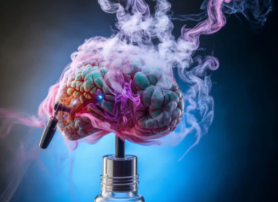It is more than just a buzz. Vaping among teens has become a scourge of the younger generation and a serious affliction to the future of the world; namely, the teenage brain. Vaping is widespread and students are inhaling nicotine and THC to their detriment. The teenage brain is still developing which makes them more susceptible to deadly addictions.
E-cigarettes and vaping rates have skyrocketed in recent years, especially among teens. According to an article on the Child Mind Institute website, “E-cigarettes are now the most frequently used tobacco product among adolescents — some 2.1 million middle and high school students were e-cigarette users in 2017 — far surpassing traditional combustible cigarettes” (Martinelli).

Photo courtesy of Sarah McGraw- Thimmes.
Sarah McGraw-Thimmes, the LCS District Health Coordinator said that there is a wide range of symptoms that may occur from vaping.
“Vaping is considered to be an epidemic, particularly among the youth in the United States. Therefore we are seeing that impact in our schools. I have seen students become extremely ill from vaping, their grades plummet as the chemicals alter their brain function, they become addicted to nicotine and they have long term lung issues,” McGraw-Thimmes said.
Moreover, deadly chemicals in vapes and e-cigs increase the risk of addiction and disease.
“Vapes contain harmful chemicals such as formaldehyde, which is known to cause cancer, and acrolein which is used as a weed killer and can cause irreversible lung damage. Nicotine is highly addictive and exposure during adolescence can harm the developing brain. In the short term, vape aerosol can irritate your lungs, throat and eyes. It can also make it more likely that you’ll catch colds or get the flu,” McGraw-Thimmes stated.

Hannah Josefczyk.
Photo courtesy of Carson
For teenagers, vaping is especially dangerous because brains aren’t fully developed until the age of 25.
“Nicotine hijacks the reward system in the brain with dopamine production, it is portraying that nicotine is easing anxiety or stress when it is doing the opposite. It can worsen academic performance by decreasing student’s ability to focus,” said Hannah Josefczyk Health educator, Fairfield County Health Department.
Vaping has become more discreet and easy to conceal. Some look like pens or flash drives. They don’t leave behind a bad smell like cigarettes. According to the National Institute, the easy availability, alluring advertisements, e-liquid flavors, and the belief that they’re safer than cigarettes have helped make them appealing to this age group. In addition, they are easy to hide from teachers and parents.
“Regarding the different vaping tools that are utilized every day in plain sight. It has definitely caused me to look more closely at what students have in their possession” said McGraw-Thimmes.
Even more so, people with addictions might now want to admit to themselves that they have an addiction, which can be very harmful long term.
“Nicotine addiction is an addiction and the first step in recovery from an addiction is admitting you have a problem and wanting to start your quit journey for yourself,” Josefczyk said.
“Education is a good place to start because most individuals don’t know the true effects of vaping and may see others do it and think it looks cool or is normal. Utilizing resources will be helpful to the individual who is addicted,” said Josefczyk.
How can anyone beat a vaping addiction? Find healthy distractions. Do physical activities like exercise. Celebrate personal accomplishments. Lean on support systems. Identify triggers and why one vapes. Remove unhealthy habits and relationships from your life. For more information, contact the Substance Abuse and Mental Health Services National Helpline at 1-800-662-4357.








